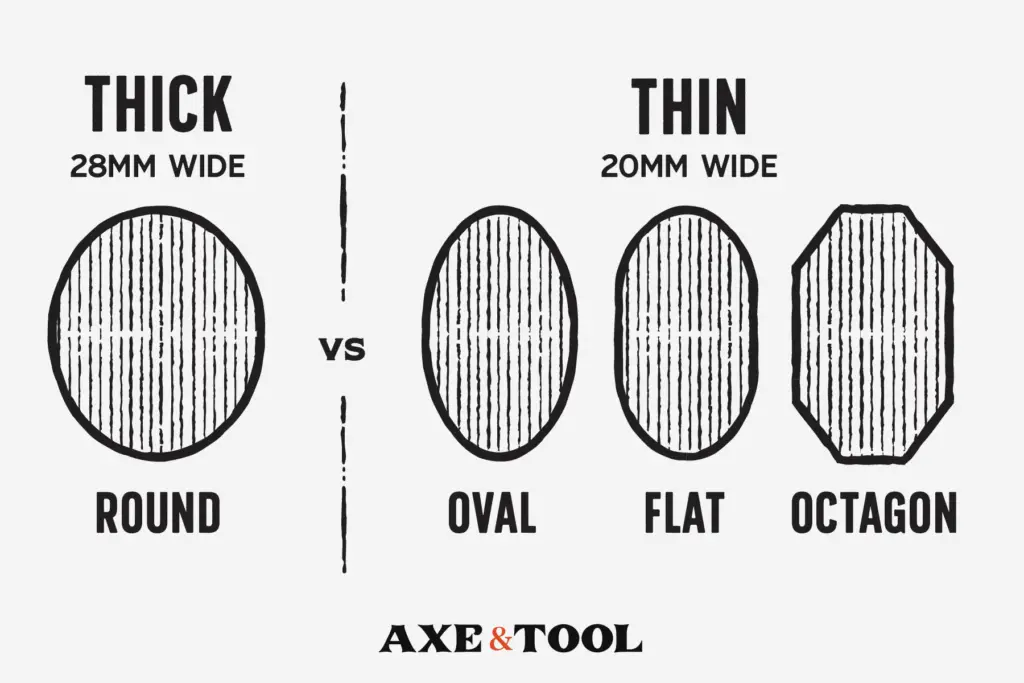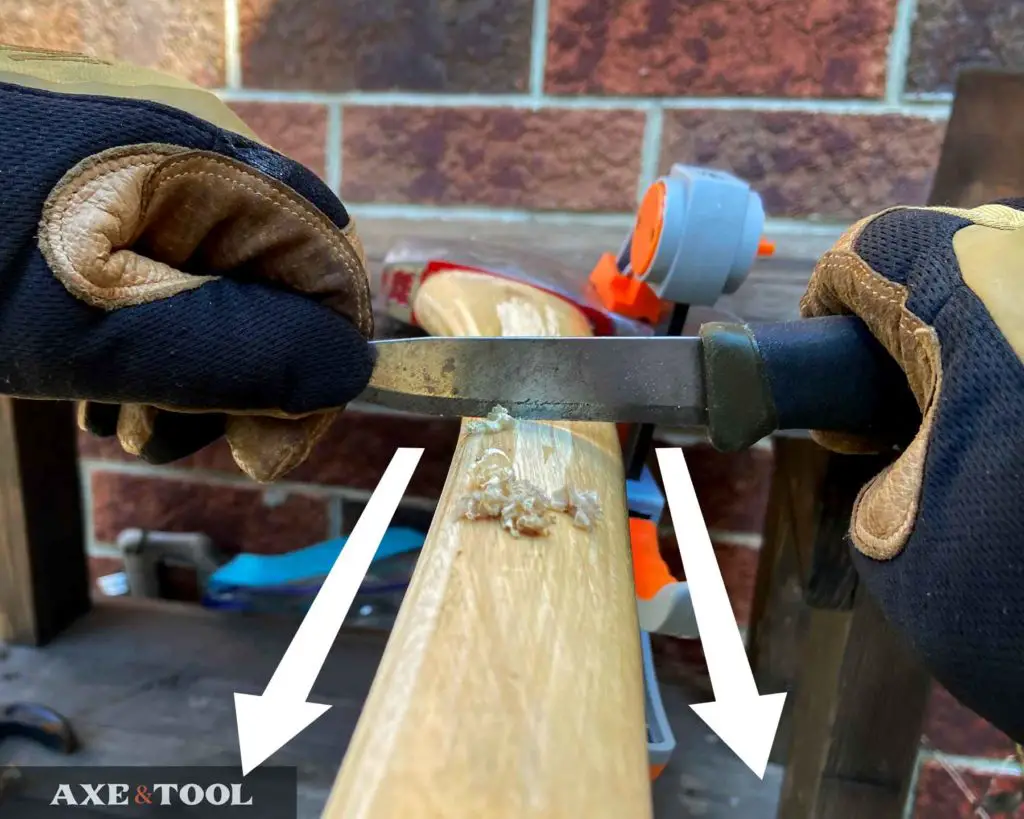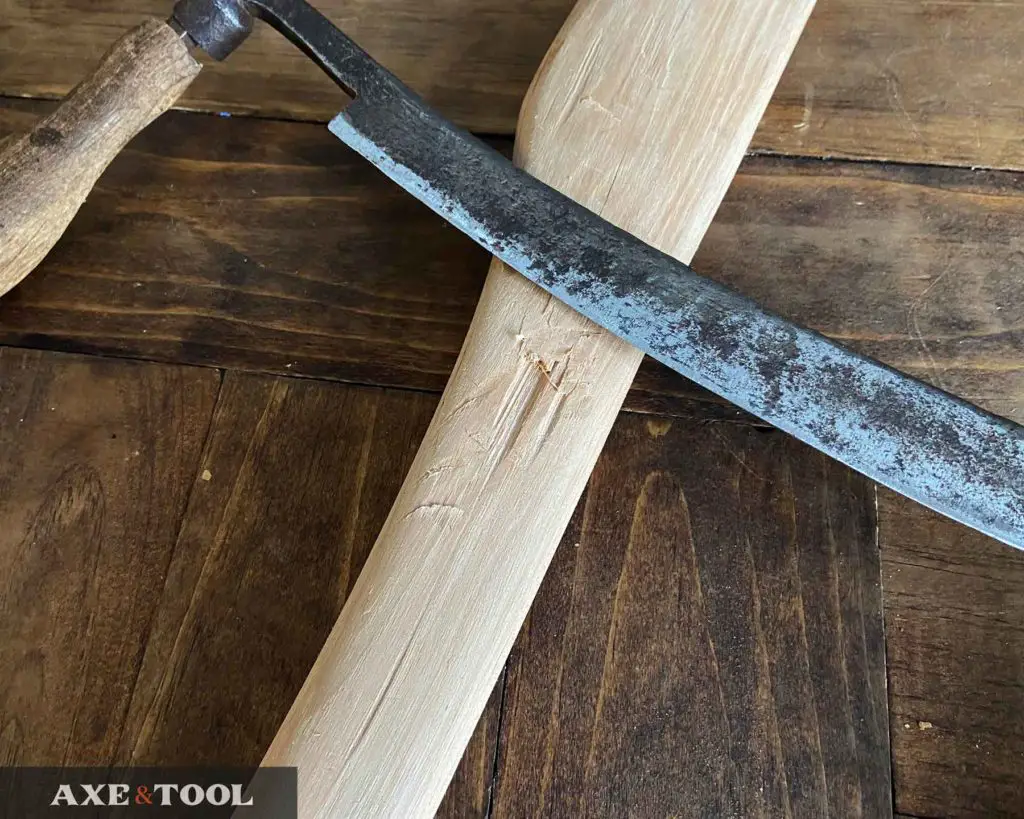How To Properly Thin An Axe Handle

Thinning the handle can be critical to making sure your axe performs the way it was intended. And fortunately, you don’t need any special tools to achieve great results.
After a bunch of trial and error, I recommend these 4 easy ways you can use to thin an axe handle:
Note: A common width for a thin handle is 19-21mm or 0.75-0.825” – but depending on the type of axe you may want something else. We have a companion guide to handle thickness here.
Why you should thin your axe handle
A thin handle makes long chopping work with your axe easier on the hands, less fatiguing, and more accurate.
A fatter handle won’t bend as much, so less of the shock is absorbed – making it felt more by the user. A fat handle is usually round, and needs to be held tighter to keep from rolling and to stay accurate. That tight grip can get tiring and again will transfer more of the shock to your hands.
A thin handle doesn’t need to be gripped tightly to lay flat with the top hand. It only needs to be guided to the tree, almost like it’s being thrown. And the shape of the thin handle makes it more accurate, because you can feel where it’s pointed.
Note: Typically most people don’t thin the handles of splitting axes, as the extra width can be useful if you need to pry wood apart – or unstick your axe. You have to be more careful with a thin handled axe that is stuck.
What shape should the handle be?
There are three typical profile shapes for a thinned handle, but it’s just a matter of preference. Some people like flatter sides, others rounder. The octagonal shape is also a classic, but is the toughest to achieve.

1. Thinning Handles with a Knife
All you need to thin an axe handle is a straight plain-edged knife.
It helps if the blade is a little on the longer side (4-6 inches), but any size can work. It doesn’t even need to be that sharp. I use mora knives a lot as they are cheap (see on amazon) and I have a bunch around the shop (so one is always within reach).

How to thin a handle with a knife:
- Secure your axe or handle.
- Drag the knife down the handle, scraping off a thin layer of wood as you go. The knife blade should be perpendicular to the handle (so if your handle is laying flat, your knife blade should be straight up and down).
- Continue scraping down the axe handle on both sides evenly until the handle is thinned to your liking.
- Sand away any scrape lines and smooth to your liking
It’s very easy to keep a consistent shape and width with this technique, as you can often scrape down the entire handle in one pull, and the shavings are thin and consistent.
A smaller blade can also easily carve curved shapes and details into the handle, allowing you to shape the hand swell.
The only real downside is this technique will likely take the most time, but it’s still my most frequently used technique.
Note: This is also the best method for removing varnish from an axe handle.
2. Rasps Remove Material Quickly
Using a good rasp to thin an axe handle is as easy as the scraping method and it removes material so much faster.

I typically start with a rasp on really fat handles (like on this Hultafors standard axe) before finishing with the knife.
Rasps are the best way to create a flat-sided handle or shape in octagonal beveled edges (rather than an oval shape).
How to thin your handle with a rasp
- Secure your axe or handle
- Push the rasp forward in a diagonal motion, working your way down the handle. Don’t just go straight down the whole length of the handle – work your way in sections.
- Smooth with a knife and/or sandpaper
It can be difficult to find large traditional rasps, or they can be quite expensive. And I have found the standard ones from the hardware store clog quickly.
That’s why I REALLY like these Japanese “saw rasps” for doing the flay sides, they rip a lot off at once and don’t clog up easily (see on Amazon). It makes it easy to thin the entire length of the handle easily.
However, the saw rasp can’t do fine detailing. I use a cheap 4-1 rasp for doing the detailing and curves in the grip or shoulder. It offers both course and fine teeth, on both flat and rounded surfaces. And you never have to swap tools, it’s all-in-one and costs like $12 (amazon).
Rasps can leave a rougher surface so I finish with a more traditional finer rasp, or a knife and sandpaper after the initial shaping is done.
3. Spokeshaves work well
If you know how to use a spokeshave, it works exactly like the first knife method.
Spokeshaves can be faster and finer than just a knife, but they require a little more skill to use. So if you have one – great. But I don’t think you need to go out and get one just for this task. If you are going to buy any tool, I would get the rasp.
Draw knives are only for shaping the eye
A good drawknife is a perfect tool for shaping the eye of an axe but don’t try and use it to thin the handle.

Drawknives cut too deeply and will be inconsistent.
The grain within an axe handle will change directions at multiple points, so you are constantly risking catching an edge and tearing out a chunk (see above).
You need to re-orient yourself regularly, and it’s just too hard to do consistently without causing problems.
If you want to find a draw knife for doing axe eyes I recommend checking facebook marketplace or flea markets for a vintage one – you can score a good deal. But if you want a new one, I recommend this one (amazon).
4. Shaping Handles with a Belt Sander
Finally, of course, you could just use a belt sander with an aggressive grit. This method can produce nice flat-sided handles or oval sides with a lighter touch and a little practice. I would start with a hand tool, and only use power tools once you get the hang of it.
Professionals use large powerful grinders to shape entire handles, but you can just flip a standard handheld sander upside down and clamp it to a table.
Once your handle is thinned you will need to properly oil it. I have a guide to properly oil your handle with a few tips I have learned over the years.
Please comment below If I missed something or if you have any questions. I do my best to respond to everyone.
About the author:
About the author:
Jim Bell | Site Creator
I’m just a guy who likes axes. I got tired of only finding crap websites, so I set out to build a better one myself.
I’m also on Instagram: @axeandtool


Could you elaborate a bit more on the desired outcome and how to decide if you want to thin the handle?
I’ve been enjoying your articles! Thanks!
Thanks for the suggestion. I added a section above for the reason to thin your handle, and what you should be trying to achieve. Hope this helps!